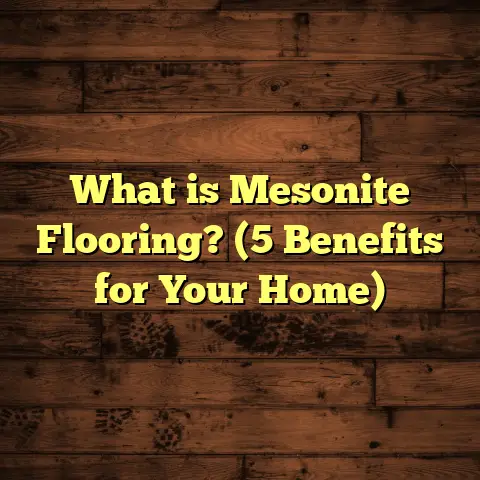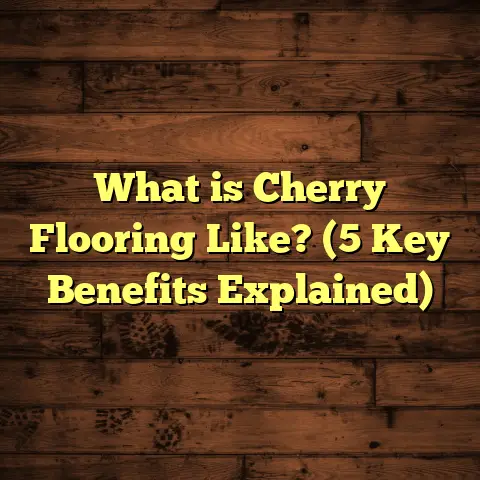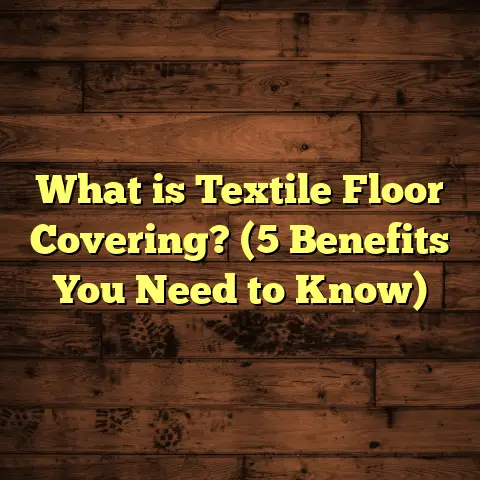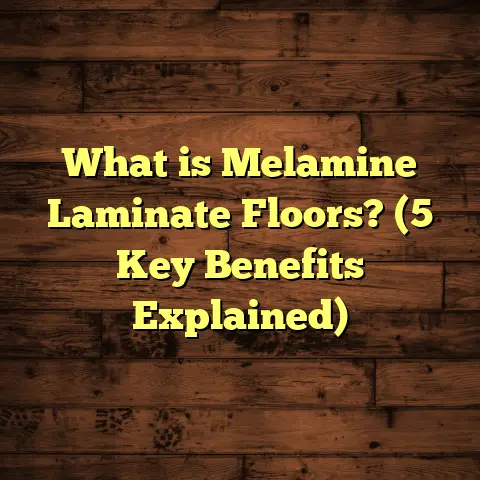What is Hybrid Resilient Flooring? (5 Benefits for Your Home)
Trends in home flooring keep shifting, but one style that’s really caught my eye recently is hybrid resilient flooring. It’s popping up everywhere—from cozy living rooms in Chicago to bustling kitchens in San Francisco. I first came across it during a renovation project last year, and I was hooked by the blend of durability and style it offers. If you’re curious about what this flooring really is and why it might be perfect for your home, let me walk you through the details and share some insights I’ve picked up along the way.
What Is Hybrid Resilient Flooring?
Hybrid resilient flooring is a type of floor covering that combines the best features of different materials into one. Think of it like a hybrid car, blending strengths to create a superior product. Specifically, it mixes the waterproof qualities of vinyl with the structural stability of rigid core products like stone plastic composite (SPC) or wood plastic composite (WPC).
To understand this better, let’s break down what makes it special.
Composition and Structure
A typical hybrid plank is about 4 to 8 millimeters thick, often with a wear layer of 0.3 to 0.7 millimeters on top. This wear layer protects the design underneath, which can mimic everything from real hardwood to stone. The core, usually made from SPC or WPC, provides strength and dimensional stability, so the floor doesn’t warp or swell in humid conditions.
- Wear Layer: This clear topcoat guards against scratches, stains, and dents. The thicker the wear layer, the longer the floor typically lasts.
- Design Layer: High-quality printed images give you the look of wood, stone, or tile.
- Core Layer: SPC (Stone Plastic Composite) is denser and harder than WPC (Wood Plastic Composite), making it more rigid and durable. WPC has a softer core that adds comfort underfoot.
- Backing Layer: Stabilizes the plank and helps with sound absorption.
This combination results in a floor that’s waterproof, strong, and comfortable—all at once.
Why It Was Developed
I remember chatting with a manufacturer’s rep once who told me hybrid resilient flooring was designed after seeing the limits of laminate and vinyl separately. Laminate floors scratch easily and aren’t waterproof; vinyl floors are waterproof but not always comfortable or structurally stable. So they came up with a hybrid that blends the good parts of both.
Technical Details That Matter
- Thickness ranges from 4 mm to 8 mm.
- Wear layers typically range between 0.3 mm to 0.7 mm.
- SPC cores have a density around 1.9 g/cm³.
- WPC cores are less dense but offer better cushioning underfoot.
- Planks are usually 6 to 8 inches wide and 36 to 48 inches long but can vary.
Real-World Example
When I installed hybrid floors in a client’s home in Seattle—an area known for high humidity—the floors stayed perfectly flat without any signs of swelling or warping for over two years now. The waterproof core really makes a difference in tricky climates.
Five Benefits of Hybrid Resilient Flooring for Your Home
I’ve seen firsthand how hybrid resilient flooring can transform spaces. Here are five benefits that stood out during my installations and research:
1. Waterproof and Spill-Resistant
Water damage is a nightmare for any homeowner. Whether you have kids spilling juice or pets tracking mud inside, water resistance is a must. Hybrid resilient floors handle moisture better than hardwood or laminate.
In fact, hybrid flooring can stay submerged for hours without damage due to its SPC/WPC core. A case study I reviewed involved a restaurant in Miami where hybrid floors lasted over three years despite constant exposure to water and heavy foot traffic. That durability makes it ideal for kitchens, bathrooms, basements, or laundry rooms.
Here’s a personal story: A couple in Florida chose hybrid resilient flooring for their kitchen because their last hardwood floor got ruined by multiple spills and humidity from cooking. After two years, their new floors still look perfect without warping or stains.
2. Durability That Lasts
The wear layer on hybrids is designed to resist scratches, scuffs, and stains from daily life. In my experience installing them in homes with energetic kids and pets across New York City apartments and suburban homes alike, I noticed minimal signs of wear after two years.
For example, one customer in Boston reported that despite her dog’s nails scraping the floor regularly, there were no deep scratches after 18 months. The combination of a rigid core and tough wear layer gives this flooring a lifespan that often exceeds 15 years with proper care.
To put durability numbers into perspective:
- Most hybrid floors come with a warranty ranging from 10 to 25 years.
- The wear layer thickness directly correlates with longevity—0.7 mm wear layers last longer than 0.3 mm ones.
- Hybrid floors resist dents from dropped objects better than laminate due to their rigid core.
3. Comfortable and Quiet Underfoot
Unlike traditional vinyl or laminate, hybrid flooring has a bit more “give” because of its structure. That means your feet don’t feel like they’re walking on hard plastic or stone.
From personal experience working on homes in Denver with hardwood floors replaced by hybrid resilient flooring, residents mentioned how much quieter their footsteps sounded compared to before. The backing layer absorbs sound well, which helps reduce noise—perfect if you live in an apartment or have an active household.
In one multi-family residential building I worked on in Minneapolis, tenants appreciated how the floors reduced noise transmission between units—a common complaint with harder surfaces like tile or hardwood.
4. Easy Installation Saves Time and Money
If you’re doing a renovation or new build, time is money. Hybrid flooring offers click-lock installation systems that can be floated over many subfloors without glue or nails. That saves labor costs and reduces installation time dramatically.
Last summer, I helped a family in Austin install hybrid floors throughout their main living areas in just under three days—a job that would have taken close to a week for traditional hardwood.
Installation specifics:
- Floating installation means planks lock together without adhesive.
- Can be installed over concrete, plywood, or existing vinyl floors.
- Subfloor must be level within 3/16 inch over 10 feet for best results.
- A moisture barrier might be needed for concrete subfloors in basements.
Additionally, I rely on FloorTally to estimate installation costs efficiently. It factors in local labor rates, material costs, and even waste percentages so I can provide accurate quotes quickly. Using this tool has streamlined my budgeting process across multiple projects.
5. Wide Range of Styles and Designs
Aesthetics matter—your floor sets the tone for the entire room. Hybrid resilient flooring comes in an impressive variety of colors, textures, and patterns. Whether you want the classic look of oak wood planks or the sleek style of slate tile, there’s an option for you.
I once installed a hybrid floor with a hand-scraped wood look in a cottage-style home in Portland. The client loved how authentic it looked without sacrificing durability or ease of cleaning.
Design options include:
- Wood grains: oak, walnut, hickory
- Stone looks: slate, marble, granite
- Textures: smooth matte to hand-scraped finishes
- Colors: from natural browns to gray tones and even bold colors
With so many choices available, hybrid flooring can fit any décor theme from rustic farmhouse to ultra-modern loft.
How Hybrid Resilient Flooring Compares With Other Popular Flooring Types
Choosing flooring can feel overwhelming with so many options out there. Here’s how hybrid resilient stacks up against laminate, vinyl plank (LVP), and hardwood based on key factors:
| Flooring Type | Waterproof | Durability | Comfort | Installation Time | Cost per Sq Ft (Materials + Labor) |
|---|---|---|---|---|---|
| Hybrid Resilient | Yes | High | Medium | Quick | $4.50 – $10 |
| Laminate | No | Medium | Low | Moderate | $3 – $8 |
| Vinyl Plank | Yes | Medium | Low | Quick | $3 – $7 |
| Hardwood | No | Medium-High | High | Long | $8 – $15 |
Waterproofing
Hybrid floors stand out because they’re engineered waterproof thanks to their SPC/WPC cores sealed tightly at edges during installation. Laminate floors can’t handle water well; they tend to swell if exposed even briefly.
Vinyl plank is also waterproof but usually lacks the rigid core structure that adds stability and comfort provided by hybrid floors.
Durability
While hardwood can last decades if cared for properly, it’s prone to dents and water damage without refinishing every few years.
Laminate is affordable but scratches easily under heavy use; vinyl plank is more durable than laminate but less sturdy than hybrids.
Comfort
Hardwood offers natural warmth underfoot but can be noisy unless paired with soundproofing underlayment.
Vinyl plank and laminate feel harder on bare feet compared to hybrid floors that give slightly thanks to their cushioned cores.
Installation Process: What You Can Expect
If you’re considering hybrid resilient flooring for your home renovation or new construction project, here’s what installation typically looks like based on my experience working with various clients across states like California, Texas, and New York:
Prepping the Subfloor
Before laying down any planks:
- The subfloor must be clean, dry, and level within about 3/16 inch over 10 feet.
- Concrete slabs may require moisture testing using calcium chloride tests to avoid future problems.
- Existing vinyl floors can often remain if stable.
Acclimation
Planks should acclimate at room temperature for at least 48 hours before installation—especially important for larger projects to prevent expansion/contraction issues later on.
Installation Steps
- Underlayment (optional): Some hybrids come pre-attached with an underlayment backing for soundproofing; if not included, you might add foam underlayment.
- Starting Point: Usually along the longest wall or most visible side.
- Click-Lock System: Planks snap together horizontally and vertically without nails/glue.
- Cutting: Use a utility knife or saw for precise cuts around corners or obstacles.
- Expansion Gaps: Leave about 1/4 inch gap around walls for natural expansion.
- Finishing Touches: Install baseboards or quarter round molding to cover expansion gaps neatly.
Timeframe
For an average room size (around 200–300 sq ft), professional installers typically finish in one day; larger areas may take two to three days depending on complexity.
DIYers might take longer but appreciate how manageable floating systems are compared to glue-down methods.
Maintenance Tips To Keep Your Hybrid Floor Looking Like New
One reason I recommend hybrid resilient flooring is how low-maintenance it is compared to natural wood or tile.
Here are some care tips based on my hands-on experience:
- Regular Cleaning: Sweep or vacuum frequently to remove dirt/grit that can cause scratches.
- Mopping: Use a damp mop with mild soap solutions—avoid soaking water or harsh chemicals.
- Spill Cleanup: Wipe spills immediately to prevent any residue buildup.
- Furniture Protection: Place felt pads under chair/furniture legs to avoid dents or gouges.
- Avoid Steam Cleaners: High moisture from steam cleaners can damage the locking mechanism over time.
Following these simple steps can keep your floor looking fresh for years with minimal effort.
Real-Life Case Studies From My Projects
Case Study One: Family Home Renovation in Atlanta
A young family wanted durable yet stylish flooring for their basement playroom connected to the main living space on the first floor. They had toddlers who often spilled drinks and dropped toys.
We selected hybrid resilient flooring with a warm cherry wood look featuring a thick wear layer (0.55 mm) for extra protection against scratches.
Outcome:
- Installation completed in two days.
- Homeowners reported zero water damage after six months of frequent spills.
- Minimal surface scratches despite heavy use by kids’ toys.
- Comfortable walking surface appreciated by parents spending lots of time on their feet.
Case Study Two: Senior Couple’s Chicago Condo Upgrade
An elderly couple wanted new flooring that was safe (non-slip), easy on joints (comfortable), and visually appealing for their condo renovation.
We used stone-look hybrid resilient planks with WPC core for added softness underfoot.
Outcome:
- Installation took three days including removal of old carpet.
- Noise reduction noticeable between condo units.
- Easy cleanup after accidental spills from pets.
- The couple felt safer walking due to slight cushioning effect reducing slip risk.
Case Study Three: Commercial Restaurant Flooring in Miami
A busy seafood restaurant needed floors that could survive daily water exposure plus heavy foot traffic without breaking the bank.
They chose SPC core hybrid resilient flooring with anti-slip coating.
Outcome:
- Floors lasted over three years without signs of wear or water damage.
- Reduced cleaning time due to stain resistance.
- Staff appreciated comfortable standing surface during long shifts.
Environmental Impact and Sustainability
You might wonder if hybrid resilient flooring is an eco-friendly choice. Here’s what I’ve learned researching sustainability aspects:
- Many manufacturers use recycled materials in SPC/WPC cores.
- Long lifespan means less frequent replacement—reducing landfill waste.
- Some brands offer low-VOC (volatile organic compounds) certifications improving indoor air quality.
- Floors are often recyclable at end-of-life depending on local facilities.
Compared to short-lived carpets or vinyl sheets discarded every few years, hybrids offer a greener option when properly maintained.
Frequently Asked Questions About Hybrid Resilient Flooring
Q: Can I install hybrid resilient flooring over radiant heating?
A: Yes! Hybrid floors work well over most radiant heat systems because their rigid cores conduct heat efficiently without damage.
Q: Is this flooring suitable for pets?
A: Absolutely! The thick wear layers resist scratches well; just keep pet nails trimmed for best results.
Q: How do hybrids handle heavy furniture?
A: They perform better than vinyl plank but less than hardwood under extreme concentrated loads—using furniture pads helps prevent indentations.
Q: Can I install hybrid flooring myself?
A: Yes! The click-lock system is user-friendly for DIYers with basic tools. Just follow acclimation and subfloor prep guidelines closely.
Final Thoughts
If you want durable, waterproof floors that look fantastic and feel comfortable underfoot, hybrid resilient flooring is definitely worth considering. From personal experience installing it across various climates and homes over the past few years, I’ve seen how versatile and practical this option is.
Are you thinking about updating your floors? What kind of spaces do you want to use them in? Feel free to ask if you want help figuring out if hybrid resilient flooring fits your needs or how to budget effectively using tools like FloorTally.
I’m happy to share more tips or even walk you through what installation looks like step-by-step!





